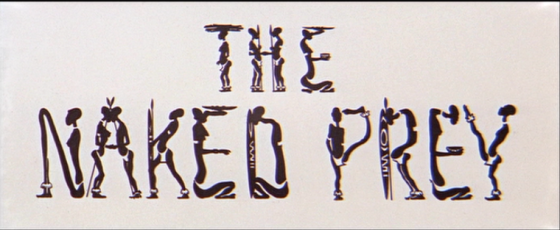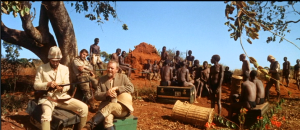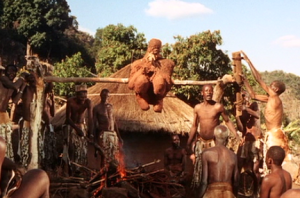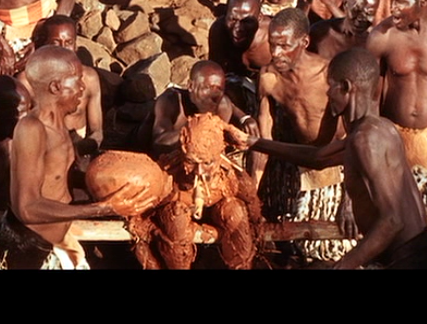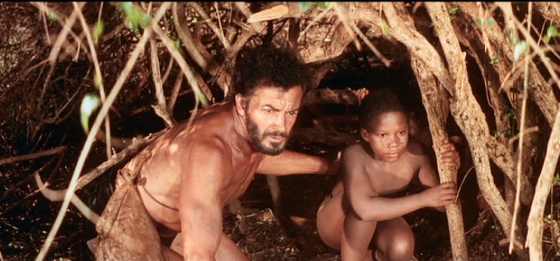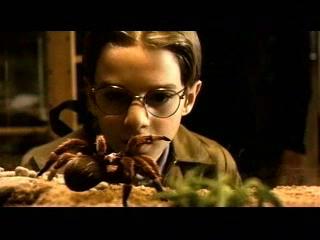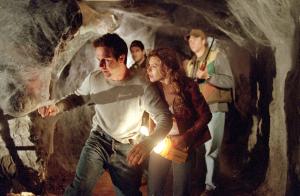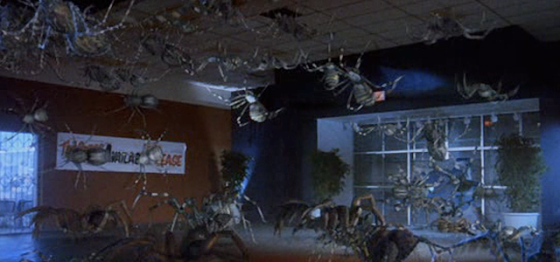I am getting ready this weekend for a Podcast on the LAMB, covering the 1995 Sam Rami film, "The Quick and the Dead". I have just watched it for maybe the thirtieth time and I am so excited to talk about the film again. The movie was one of eight that I submitted to be Movie of the Month on the Lambcast. As host, I get to select the films that the community votes for in my Birthday Month. While it is at least the fourth time I have submitted "The Man Who Would be King" as a MOTM option, I am perfectly happy with the results found here because I clearly love this film.
Let me point to the two biggest factors that draw me to this movie. First of all, it is a western, and they don't make them much any more. The early 90s saw a brief revival of the genre, lead in part by the fantastic Clint Eastwood film, "Unforgiven". At the time this was shot, there were a number of other westerns being made and reportedly, costumes became a little sparse. When I was growing up, most of the westerns being released were post modern critiques of the traditional genre. "The Man who Shot Liberty Vallance", "The Wild Bunch", and the spaghetti westerns of Sergio Leone, focused on breaking down the myths of the western, and giving us anti-heroes as our protagonists. Of course there were television westerns all over the three major networks, and that saturation probably lead to the decline of the film genre. While some of those featured unconventional heroes, none of them that I remember were out right bad guys for us to root for. Leone and Sam Peckinpah turned shady characters into the stars of their films and ever since, there is a delicate morality to the movies.
The second major factor that keeps me hypnotized by this film is the performance of Gene Hackman. I have made no secret of the fact that Hackman is my favorite actor. He is not movie star handsome, he is not chiseled like a superhero, and unfortunately, he stopped working in movies in 2004. The thing that he is is talented. He seems to have an instinct for the characters he is playing and the everyman quality he brings to the screen, actually enhances both his roles as good guy and as villain. In "The Quick and the Dead", he is clearly the later. Unlike the brutal sheriff of Big Whiskey, that he won the Academy Award for best supporting actor in "Unforgiven", John Herod, the town of Redemptions usurper king, has no pretentions as to morality and justice. He is a self centered monster who rules with an iron sidearm and an iron fist. More about his performance in a bit.
So those are the two primary draws, but they are not the only sugar bringing this fly to the table. The star and co-producer of the film is Sharon Stone. This film came out the same year as her Academy Award Nominated role in "Casino". She was at the height of her star power and sexual charisma, and she is using it in this movie. There is something striking about a woman in the traditional gunfighter's role that makes it compelling. The film is drawing on her bigger than life persona to turn her character into the person that we most want to see succeed in the story. The fact that her wardrobe flatters her, and she still gets to wear very western garb is visually satisfying in almost every scene. "The Lady" as she is usually referred to as, wears a her holster and the gun at a slightly different angle. Her style is also just different enough to be noticeable without it becoming an artificial conceit. Slightly forward on her hip rather than low and on the outside.When it comes to talent and charisma, the film does not run out of steam with the two leads. There are two actors billed after Hackman and Stone who will dominate the masculine acting roles for the next twenty five years. Russel Crowe is making his American film debut with this appearance and he quickly leans into Sam Rami's style and looks the heartthrob that he would become for a decade after.
The part of Cort, gives him a meaty role that allows him to act as well as engage in the action. He is a reformed criminal who is doing penance for his previous life by taking up the role of preacher and is reluctantly dragged back in to the town by the will of his former mentor and now enemy, Herod. His conflicted participation in the quick draw contest that frames the story is dramatically satisfying without sucking up all the air in the revenge drama that Stone's character is playing out. Speaking of heartthrobs, this movie features a young actor, fresh off of his first Academy Award Nomination and just two years away from playing the biggest romantic lead in the biggest romantic movie of the last fifty years. Leonardo DiCaprio, was 20 years old when he played the part of Fee, better known as The Kid, opposite the three other acting legends. He looks like he is twelve, and playing cowboys with the big kids. He does however have a winning smile and a effervescent way of talking that belies the characters desperation to be accepted at the grown up table by his suspected true father, Herod. Of all the actors, he needs the most help with the gunplay required of his part. He manages the bravado of the tricks and the poses, but he just seems slow in comparison to everyone else. |
| Cantrell in the background Ace up front. |
Momentarily I will get to the plot and it's connection to the Leone films of the 1960s, but one actor who appears in the flashback sequences should also be named. A year after his nomination for Best Supporting Actor in Forrest Gump, Gary Sinise, plays the long ago Marshall of the town of Redemption. His character is the catalyst for the revenge story that Sharon Stone is following. Even though his scene is broken up into bits for the brief flashbacks, he creates a sympathetic character that the audience can see as important to the story arc that Ellen (The Lady) is carrying out. Sinise does the whole scene balanced on a chair and choking. What happens creates a different kind of choking on the part of the audience.
The film's story and the look of the movie, are clearly influenced by Sergio Leone and Clint Eastwood. There is an entrance based on riding by the local undertaker as they enter the town, In "A Fist Full of Dollars" Clint tells the man to get three coffins ready, here, the coffin maker speaks and accurately states the height of Stone's character, suggesting he will be ready when her turn comes. The duster she wears is not the same as the poncho that the Man with No Name wears in the Dollars Trilogy, but she does have a scarf that gives a very similar effect in her appearance and both of them seem to favor the same tobaccoist.
"The Quick and the Dead" is Sam Rami's homage to the spaghetti westerns of the 60s and 70s. There are tense close ups in the build to each showdown. The eyes of the characters are doing so much of the acting in those scenes that we barely notice the rest of the surroundings. Rami cross cuts tightly and the images close in, just as Leone did in so many of his films. There is a scene in a gun shop in "The Good, the Bad and the Ugly, where Eli Wallach's character Tuco, is examining the guns and clicking through the cylinders. Crowe does the same thing as Herod takes him to get armed for the contest in Fee's shop. Woody Strode, the athlete turned actor who supported John Wayne in Liberty Vallance, and tried to gun down Charles Bronson in "Once Upon a Time in the West" makes his final screen appearance in this film as the coffin maker and the movie is dedicated to him. The most obvious steal is the scene featuring Sinise. Sharon Stone is a much more attractive version of Charles Bronson's Harmonica from "Once Upon a Time in the West".
For every idea and stylistic flourish that Rami takes from Leone, he brings his own original style to the movie as well. The dolly zooms that he used so much in the Evil Dead films, fit perfectly in several spots in this movie. The gunfighters stand far apart from one another, but we can feel the tension ratchet up as the next shot zooms the opponent in at a weird Dutch angle.
All of these tricks are needed to help overcome the somewhat repetitive showdown in the street structure of the story. This is a quick draw contest, ultimately to the death, and there are 16 participants so there are going to be a lot of gunfights in the movie that are one on one in the main street of the town of Redemption. When I have seen negative reviews of this film, they often claim that the story is boring because the same event is reenacted over and over. Siskel and Ebert gave the movie Two Thumbs down for that very reason. What people are missing ate the innovative ways each of those gunfights is shot. There are also twists in several of the face offs that make the each contest unique. Additionally, the music themes play up different emotional beats for the fights. Sometimes the score is nearly whimsical and other times it is thunderous.
Two of Herod's fights demonstrate this. The showdown with Ace Hanlon is slow to develop and then like a whip, the first shot is cracked and then we get a villain's exposition from Hackman that is so condescending, the end is almost a relief to Ace. With Cantrell, we get two extra shots, one that spins his fancy sidearm around after the man has been shot and then the Coup de Grâce, a point of view shot that is disturbing and inventive and new to the genre. The TV critics down play it as grotesque, but let's face it, the deadly combat in and of itself is also morbid.
Back to Gene hackman for a few minutes. Herod is an egoist who wants everything to go his way. He demands the retorn of Cort to his town, just so he can lord over him the power that he has. He is dismissive of The Lady at first and then tries to manipulate her to his will. At the dinner scene, Ellen gets the drop on him with a small gun under the table, hidden from view. Herod hears the hammer being cocked and responds with a similar sound to dissuade her from shooting. After she blinks, he gives away the fact that he was bluffing with the hammercock sound he produced, using a metal matchbox. He smiles smugly in his victory over her as she retreats. Hackman does these kinds of smiles and small hand gestures throughout the picture. Before his gunfight with Cantrell, he meticulously files the hammer on his disassembled firearm, to insure it is working properly. Rami tags on a slow motion shot when Hackman is lighting his cigar during a showdown, which accentuates the moment but it is the deliberate manner he uses in a casual way that sells his total control of the situation. Just to add one more element to Hackman's complete command of the part, he looks elegant in all of his costumes, including the sidearms that go around his suit jacket in one scene.









